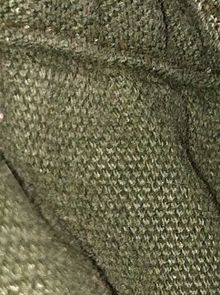Canvas (fabric)
Canvas , also called duck , is a fabric made of strong yarn that is tightly and tightly woven. The name comes from English and refers to historical canvas .
etymology
Originally, fabrics for sailcloth were mostly made of pure hemp and linen , cotton was only used from the beginning of the 19th century. The English term canvas for sailcloth derives from the use of hemp as sailcloth , canvas comes from the 13th century from the Anglo-Saxon Canevaz and from the old French Canevas (canvas), it is derived from the ( Latin cannapaceus ) for cannabis “from hemp “And from the Greek word κάνναβις (cannabis). "Canvas" became a global term through the supremacy of the British Empire and later, after the Second World War , through global Americanization . The term "Duck" for "canvas" is derived from the Dutch ( zeildoek : Canvas; doek : cloth) and comes along that sooner sailcloth in England were imported from Holland.
The terms “canvas” and “duck” are synonymous, but the term “duck” is rather rare in German-speaking countries.
Material and use
Canvas is made from natural fibers such as cotton , hemp , linen, but also mixed with various chemical fibers such as polyester , copolymer (polyacrylic), etc. Depending on the area of application (maritime or otherwise), canvas is appropriately woven , equipped , impregnated or coated and sanforized .
For special applications, as well as in public areas and buildings, materials are available that meet the legally required safety in the area of fire protection . Such materials are impregnated to be flame-retardant in accordance with DIN 4102 B1 or are made from permanently flame-retardant materials.
Canvas is also in different weaves produced in original plain weave (1 x 1), as well as in Halbpanama- (2 x 1), basket weave (2 x 2), and Ripstop .
Canvas is in great demand because of its properties and is used for many textile applications. The Colosseum in Rome was already covered with a velarium (sun sail) as sun protection. Other uses include tents, clothing, tarpaulin , bags or rucksacks , hats , folding buckets, etc. As sailcloth, canvas is not only used for ships' sails, but also as the main material for lightweight boats (" wood and canvas "). Canvas also serves as a light sail (for sail lamps) and as a canvas in painting.
The first pants by Levi Strauss were made, the future inventor of denim - jeans were made of canvas. The first shoe with a rubber sole (Plimsoll) also had an upper made of canvas, in a sense the first sneaker . Earlier fire hoses were also made from canvas and the first pneumatic tires were covered with canvas.
Canvas is available in different thread sizes, the thread size is given in denier . The abrasion resistance is given in Martindale .
The weight from which fabric counts as "canvas" is not precisely defined, it is between 6 oz./Sm. oz .; 257 g / m 2 , based on the weight division of the old system of measurement and 7 oz./sq. Yard; 237 g / m 2 , what is produced today (see under material). If the weight is lower, it is actually no longer “canvas” in the classic sense, but rather nettle fabric (here we do not mean “real nettle fabric”), canvas, aircraft fabric or balloon fabric.
The material weight is defined by various dimensions:
| Grams per square meter - GSM , ounces per square yard - GB oz. = 33.91 g / m 2 , as well as "Sailmakers Ounces" ( Sm. Oz ; US oz. )
→ Ounces per "sailmaker's yard" (= 36 inches x 28.5 inches = 914.4 mm x 723.9 mm) = 42.83 g / m 2 , this corresponds to 1.263 times GB oz. The following applies: 1 ounce = 28.35 grams; 1 inch = 2.54 cm; 1 yard = 91.44 cm. |
In America the substances are differentiated according to an old system, which is still in use. It refers to cotton fabrics that have not been pretreated
|
Note: A "linear yard" refers to a one yard long panel of fabric of a certain width.
Web links
Individual evidence
- ^ Jenny Bennett: Sailing into the Past: Learning from Replica Ships. Seaforth Publishing, 2009, ISBN 978-1-84832-013-0 , p. 184.
- ^ The Online Etymology Dictionary . Etymonline.com. Retrieved May 5, 2012.
- ^ Oxford Dictionaries . Oxford University Press. Retrieved March 1, 2014.
- ^ Charles Pope: A practical abridgement of the custom and excise law. Second Edition, Robert Baldwin, London 1814, p. 455.
- ↑ canvas . Dict CC. Retrieved April 7, 2016.
- ↑ What is canvas? . Retrieved February 10, 2015.
- ↑ Levi's Brown Duck Trousers . Americanhistory.si.edu. Retrieved April 6, 2016.
- ↑ Linen (PDF; 154 kB). Die-Leinenweber.de. Retrieved April 8, 2016.
- ↑ Géza Austerweil: Applied chemistry in aviation. BoD - Books on Demand, 2013, ISBN 978-3-95580-168-7 .
- ^ George Bartholomew Haven: Industrial Fabrics: A Handbook for Engineers, Purchasing Agents and Salesmen. Wellington Sears Company, 1949.
- ↑ Converter for canvas weights . Hansa-segel.de. Retrieved April 4, 2016.
- ↑ The weight of the canvas is understandable . Sailingace.com. Retrieved April 5, 2016.
- ↑ Canvas Terms . (PDF; 258 kB). Utrechtart.com. Retrieved April 8, 2016.
- ^ Farmers' Bulletin. Issues 251-260, 1921, Issues 1151-1175, 1947, Issues 2170-2173, 1978, U.S. Government Printing Office.
- ↑ Duck Sizes , Sizes.com. Retrieved April 7, 2016.
- ↑ Canvas qualities . Humphrys.biz. Retrieved April 8, 2016.







